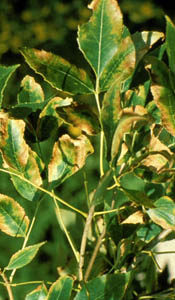Ash Decline | |
|---|---|
| September 11, 2007 | |
|
The Plant Clinic continues to receive ash samples from those concerned about poor plant vitality, thinning of branches in the canopy, branch tip death, leaf drop, and possibly scorch symptoms. One possible cause is ash yellows, but we are not equipped to adequately test for this disease at the U of I Plant Clinic. It is a problem in Illinois, but one that is difficult to quantify because presence of the pathogen is difficult to confirm. Ash yellows disease is caused by a phytoplasma. These pathogens are somewhat like virus particles, cannot be cultured in a lab, and are spread by phloem-feeding insects. They are limited to the phloem tissue of the tree. Yellows disease is characterized by a loss of vigor over 2 to 10 years before the tree dies. Symptoms include short internodes and tufting of foliage at branch ends. Leaves become pale green to chlorotic (yellowed) and might develop fall colors prematurely. The tree may or may not defoliate, but the canopy generally appears sparse. Cankers form on both branches and the trunk, causing twigs and branches to die back. Witches’-broom sprouts of growth might appear on some branches but are more common on the trunk near the ground. Cracks in the trunk may appear in this area as well. AGDIA, Inc., a private company in Indiana, can test for phytoplasmas. Visit www.agdia.com for more information and a toll-free 800 number. The cost for phytoplasma testing varies with the number of samples being tested. The procedure is very time-consuming and costly. Turn-around time also affects the cost, so if you need results quickly it costs more. For this test, AGDIA needs live, thick bark from the base of the tree. The sample must include phloem tissues and must be deep enough to prevent phloem tissue from drying out. It is advised that you call the testing service of choice before sending a sample. It is obvious why this disease has not been confirmed frequently in Illinois. Verticillium wilt of ash occurs in Illinois and has been isolated from live, affected petioles. This disease is also associated with cankers, dieback, and sometimes foliar scorching of ash. The Verticillium fungus can be isolated in the lab on traditional agars. The process requires 10 to 14 days incubation. Ash decline is a term that is often used loosely by many diagnosticians to refer to more than one condition. Ash decline may involve ash yellows disease or even Verticillium wilt, but it is often used to indicate any decline of ash for which a single pathogenic cause has not been identified. Ash decline usually includes branch tip death, defoliation of enough leaves to give the tree a sparse look, and a slow decline of the tree over a number of years.  Scorching is common. Trees with ash decline may appear to be recovering each year in the spring and then decline in July and August. Keep in mind that deep planting, girdling roots, mulch mounds around the trunk, soil compaction, root injury, and other common landscape problems can contribute to ash decline. There are no cures for any of these maladies of ash. Suggested management to slow disease progression includes removing trees with severe dieback, watering the trees in periods of extended drought lasting at least 2 weeks, and fertilizing in the fall with a balanced tree fertilizer. Removal of dead limbs may help as well. Ash trees are very resilient and may respond well to this pampering. In addition, pull mulch away from the trunk and keep weed trimmers away as well. | |
| Author: | Nancy Pataky |
